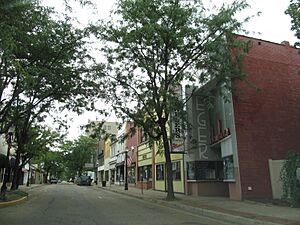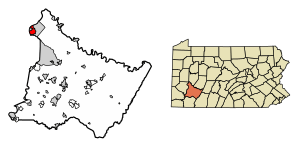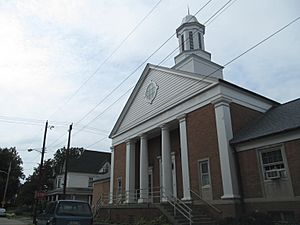New Kensington, Pennsylvania facts for kids
Quick facts for kids
New Kensington, Pennsylvania
|
|
|---|---|

Downtown New Kensington in 2012
|
|

Location in Westmoreland County, Pennsylvania
|
|
| Country | United States |
| State | Pennsylvania |
| County | Westmoreland |
| Incorporated | Nov 26, 1892 |
| Area | |
| • Total | 4.26 sq mi (11.03 km2) |
| • Land | 3.95 sq mi (10.23 km2) |
| • Water | 0.31 sq mi (0.81 km2) |
| Elevation | 1,110 ft (338.3 m) |
| Population
(2020)
|
|
| • Total | 12,170 |
| • Density | 3,081.79/sq mi (1,189.84/km2) |
| Time zone | UTC-5 (Eastern) |
| • Summer (DST) | UTC-4 (Eastern) |
| ZIP code |
15068,15069
|
| Area code(s) | 724, 878 |
| School District | New Kensington-Arnold |
| Website | http://newkensingtononline.com |
New Kensington is a city in Westmoreland County, Pennsylvania, United States. People who live there often call it New Ken. It is located along the Allegheny River, about 18 miles (29 km) northeast of Pittsburgh. New Kensington is part of the larger Pittsburgh area. In 2020, about 12,170 people lived in the city.
Contents
History of New Kensington
Early Days and Founding
Long ago, the area where New Kensington now stands was a hunting ground for Native American tribes known as the Six Nations. White settlers started to arrive in the mid-1700s. In 1777, soldiers from the Continental Army built a fort called Fort Crawford near Pucketa Creek. This fort was later left empty in 1793.
New Kensington was officially founded in 1891. Before that, it was part of Burrell Township. In 1890, a company called the Burrell Improvement Company thought the flat land south of Lower Burrell would be a great place for a new city. They first named it "Kensington." However, they changed it to "New Kensington" to avoid confusion with a neighborhood in Philadelphia that had the same name.
City Planning and Growth
To make New Kensington similar to Pittsburgh, the city planners used numbers for street names. Avenues ran next to the river, and streets ran straight across from the river. The main shopping areas were 4th and 5th avenues.
A public sale of land happened on June 10, 1891. Many people came, and investors started to bring new businesses to the area. The first big company was the Pittsburgh Reduction Company, which later became Alcoa. They bought a large piece of land by the river, which was perfect for their business. The Alcoa factory stayed open until 1971.
Over time, many other companies opened in New Kensington. These included Adams Drilling, Goldsmith and Lowerburg, New Kensington Milling, and Logan Lumber. By the early 1900s, the city had a railroad station, a bridge (the 9th Street bridge), and even a passenger boat on the Allegheny River. There was also a streetcar line, a newspaper called the Kensington Dispatch, a fire department, a hotel, and a local YMCA. In 1939, New Kensington grew bigger by adding the nearby town of Parnassus.
Modern Housing and Historic Places
In 1941, a special housing project called the Aluminum City Terrace was built in New Kensington. It was designed by famous architects Marcel Breuer and Walter Gropius. They were part of the famous Bauhaus School of Design. This project was first for workers at the Alcoa factory who helped with defense efforts. Later, it helped people who had to move from other parts of the city find new homes. In 1948, the people living there bought the project from the U.S. government. They formed a co-op, which means they all own and manage it together. This helps keep the housing costs low.
Today, New Kensington has several neighborhoods, including Parnassus, Mount Vernon, and Pine Manor. Some important places in New Kensington are listed on the National Register of Historic Places. These include the New Kensington Downtown Historic District, the New Kensington Production Works Historic District, and the Mount St. Peter Roman Catholic Church.
Climate
New Kensington has a climate with four distinct seasons. Winters are cold and often snowy, while summers are warm to hot. This type of weather is known as a humid continental climate.
| Climate data for New Kensington, Pennsylvania (Acmetonia Lock 3) 1991–2020 Normals (Temperature records 1978–Present, Precipitation 1905–Present) | |||||||||||||
|---|---|---|---|---|---|---|---|---|---|---|---|---|---|
| Month | Jan | Feb | Mar | Apr | May | Jun | Jul | Aug | Sep | Oct | Nov | Dec | Year |
| Record high °F (°C) | 67 (19) |
75 (24) |
79 (26) |
87 (31) |
94 (34) |
97 (36) |
101 (38) |
96 (36) |
95 (35) |
89 (32) |
74 (23) |
67 (19) |
101 (38) |
| Mean daily maximum °F (°C) | 35.8 (2.1) |
39.6 (4.2) |
48.6 (9.2) |
61.8 (16.6) |
71.8 (22.1) |
79.2 (26.2) |
83.2 (28.4) |
81.9 (27.7) |
75.5 (24.2) |
63.5 (17.5) |
51.4 (10.8) |
41.6 (5.3) |
61.2 (16.2) |
| Daily mean °F (°C) | 27.6 (−2.4) |
30.3 (−0.9) |
38.1 (3.4) |
49.9 (9.9) |
60.2 (15.7) |
68.4 (20.2) |
72.7 (22.6) |
71.2 (21.8) |
64.6 (18.1) |
53.1 (11.7) |
41.6 (5.3) |
33.6 (0.9) |
50.9 (10.5) |
| Mean daily minimum °F (°C) | 19.4 (−7.0) |
20.9 (−6.2) |
27.5 (−2.5) |
37.9 (3.3) |
48.5 (9.2) |
57.5 (14.2) |
62.2 (16.8) |
60.5 (15.8) |
53.7 (12.1) |
42.6 (5.9) |
31.7 (−0.2) |
25.5 (−3.6) |
40.7 (4.8) |
| Record low °F (°C) | −6 (−21) |
−9 (−23) |
0 (−18) |
20 (−7) |
29 (−2) |
40 (4) |
49 (9) |
39 (4) |
39 (4) |
30 (−1) |
11 (−12) |
0 (−18) |
−9 (−23) |
| Average precipitation inches (mm) | 3.38 (86) |
2.87 (73) |
3.68 (93) |
3.70 (94) |
3.91 (99) |
4.45 (113) |
4.54 (115) |
3.56 (90) |
4.18 (106) |
3.32 (84) |
3.26 (83) |
3.66 (93) |
44.51 (1,131) |
| Average precipitation days (≥ 0.01 in) | 18 | 14 | 13 | 13 | 13 | 11 | 10 | 9 | 10 | 11 | 12 | 15 | 142 |
| Source: NOAA | |||||||||||||
Population Changes
| Historical population | |||
|---|---|---|---|
| Census | Pop. | %± | |
| 1900 | 4,665 | — | |
| 1910 | 7,707 | 65.2% | |
| 1920 | 11,987 | 55.5% | |
| 1930 | 16,762 | 39.8% | |
| 1940 | 24,055 | 43.5% | |
| 1950 | 25,146 | 4.5% | |
| 1960 | 23,485 | −6.6% | |
| 1970 | 20,312 | −13.5% | |
| 1980 | 17,660 | −13.1% | |
| 1990 | 15,894 | −10.0% | |
| 2000 | 14,701 | −7.5% | |
| 2010 | 13,116 | −10.8% | |
| 2020 | 12,170 | −7.2% | |
| Sources: | |||
New Kensington's population has changed a lot over the years. In 1900, about 4,665 people lived there. The population grew steadily, reaching its highest point in 1950 with over 25,000 residents. Since then, the number of people living in New Kensington has slowly decreased. In 2020, the population was 12,170.
City Services and Organizations
New Kensington has its own important services to help the city run smoothly. These include:
- A public works department that takes care of roads and other city property.
- A fire department to put out fires and help in emergencies.
- A police force to keep everyone safe.
- An emergency rescue team.
- A water authority that provides clean water.
The city also has parks for recreation, like Memorial Park and Masa Harbison Park. If you need a book, the People's Library of New Kensington is there to help. For getting around, you can use public transportation provided by the Port Authority of Allegheny County and the Westmoreland County Transit Authority. There are also over thirty churches in the city.
Since the 1970s, the downtown area of New Kensington has had many empty buildings. To help fix this, the city has been working to tear down old, unused buildings and encourage new businesses to open.
Education
Students in New Kensington attend schools in the New Kensington–Arnold School District. The main schools are:
- Valley High School
- Valley Middle School (now called Roy A Hunt Elementary)
- H. D. Berkey Intermediate School
Some elementary schools, like Greenwald Memorial and Fort Crawford, closed in 2015 due to budget issues. Greenwald Memorial was sold and became the new location for St. Josephs School, a private Catholic school.
Other private schools in the city include Mary Queen of Apostles and Harvest Baptist Academy.
New Kensington also has higher education options. A branch of Pennsylvania State University opened here in 1958. It moved to Upper Burrell Township in 1966 but is still called Penn State New Kensington. In 2008, a branch of Westmoreland County Community College also opened in downtown New Kensington.
Notable People from New Kensington
Many interesting people have come from New Kensington:
- Eddie Adams: A famous photographer.
- Rachel Carson: A marine biologist and writer who helped start the modern environmental movement.
- Corey Graves: A commentator for WWE and a former wrestler.
- Stephanie Kwolek: A chemist who invented Kevlar, a very strong material used in bulletproof vests.
- Skyy Moore: A professional American football wide receiver for the Kansas City Chiefs.
- Willie Thrower: A professional American football quarterback who was the first African American quarterback to play in the NFL in the modern era.
Images for kids
See also
 In Spanish: New Kensington para niños
In Spanish: New Kensington para niños




